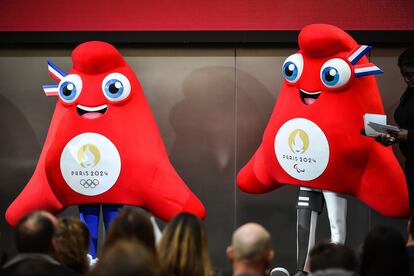Olympic France’s happy clitoris
The first Olympic mascot that is political, red, sexual and feminist has arrived to represent the Paris 2024 Games

Are you familiar with the Phryges, the new mascots of the Paris 2024 Olympic Games? They are red, feminine, horny and smiley. They are also shaped like clitorises. Until now, Olympic mascots were inspired by animals (sheepdogs, pandas, monkeys, hedgehogs...) but, suddenly, France has come along and made its symbol two beautiful clitorises. Very soon, perhaps, they will represent Paris as well. In fact, after being introduced to the Phryges, some have already started to claim that the Eiffel Tower is too phallic to represent the city of love. How did this happen? Very simple: its creators wanted to depict the patriotic French Phrygian cap. But in so doing, they gave life to two giant clitorises that are smiling gloriously at the whole world.
There’s no doubt that the Phryges are two clitorises. I mean, it’s almost obscene how much they look alike. They look so much like a clitoris that the Vagina Museum in London has availed itself of the opportunity the mascots offered to post a guide to their anatomy, which they illustrate by pointing to the mascots’ precious clitoral glans. They have it all: the urethral and vaginal openings, the cavernous body and the root. They are a perfect anatomical representation. And I wonder: can anyone imagine a neon cock with little eyes becoming an Olympic mascot? Obviously, that could not have happened. Of course, many people see, approve and celebrate the mascot that will represent a country in the Olympic Games. So, if the French Phrygian cap had looked like a phallus, someone would have noticed and said: “Hey, we can’t make our mascot a giant penis.” But because they’re two big red clitorises instead, it turns out that no one recognized what they were.
We've published a new guide to the anatomy of the clitoris! Here's the parts of the internal and external organ. pic.twitter.com/h2fJpSDOoT
— Vagina Museum (@vagina_museum) November 15, 2022
Nobody noticed because there’s a vast lack of knowledge about the clitoris. From the perspective of sexual education, the visibility of the Phryges offers us a golden opportunity, given that our cultural heritage has historically mangled the anatomy of the clitoris to the point that, even today, the organ is not represented in textbooks. As incredible as it may seem, we have only known the clitoris as we do now since 1998, when Australian urologist Helen O’Connell published her findings. She discovered that the glans of the clitoris is only the tip of the iceberg: the entire organ measures between seven and ten centimeters and has two pillars that extend and embrace the vaginal sides. In addition, the clitoris becomes aroused and hard and bursts with pleasure at orgasm. However, even today, the clitoris has not yet achieved the visibility it deserves. Maybe that’s why the erotic charge of the pretty Phryges went unnoticed so easily. Because mental images, such as the one written by Jean-Paul Sartre in Being and Nothingness, still weigh heavily: “The female sexual parts are (...) a call to being, as are all holes; in themselves, the woman calls to a strange flesh that must transform it into the fullness of being by penetration and dilution.” This profound anatomical ignorance not only leads to a misconception of the world, but also to sexual relations that can give rise to perverse power relations. The visual artist and author Liv Strömquist trenchantly makes this point in detail in her Fruit of Knowledge.
That’s why the popularization to which the Phryges will undoubtedly contribute will also have favorable political consequences. Because our way of imagining female sexuality has not been scientific or anatomical; it has been political. Of course, biological ignorance facilitates deception. Thus, even the brilliant Sigmund Freud boldly claimed that young and immature women had clitoral orgasms, while mature female sexuality meant experiencing vaginal orgasms. That abominable concept led the father of deep psychology to consider female masturbation (and any clitoral stimulation) as superfluous and inappropriate. According to him, women who did not achieve orgasm during intercourse were frigid. Thus, heterosexual sex has traditionally been understood as synonymous with penetration. That representation has had serious political consequences: for example, until 2012, the penis was an essential element of the crime of rape in the United States. Another example is that the orgasm gap remains a gender gap, as María Hesse reminded us in her excellent and celebrated book Pleasure (El placer). In her tome, Hesse drew many beautiful clitorises, one of which became the cover of El País Weekly in February 2020. Among other things, she reminded us that 95% of heterosexual men reach orgasm during intercourse with their partners while only 65% of women do, according to data published in Archives of Sexual Behaviour in 2018. That shouldn’t surprise us when we consider the great success of the Freudian sexual imaginary. Today, we know that all female orgasms are clitoral, and that penetration is absurdly overrated as a source of female pleasure.
Thus, the Phryges have become a perfect metaphor for all the silences and amputations -- symbolic and otherwise; the clitoris remains a forbidden and mutilated organ in some countries of the world -- that concern the feminine; it turns out that we cannot see or name what we have not learned to look at. That is to say, we do not see what is front of us, but instead what we can recognize. Twenty years ago, the whole world would have believed that the Phryges were two Phrygian caps. Today, however, men and women alike have begun to note and celebrate the fact that there are two clitorises bearing the French flag, as if the female orgasm were a new addition to the French Republic’s cry of liberty, equality and fraternity. The first political, red, sexual and feminist Olympic mascot has arrived.
Sign up for our weekly newsletter to get more English-language news coverage from EL PAÍS USA Edition
Tu suscripción se está usando en otro dispositivo
¿Quieres añadir otro usuario a tu suscripción?
Si continúas leyendo en este dispositivo, no se podrá leer en el otro.
FlechaTu suscripción se está usando en otro dispositivo y solo puedes acceder a EL PAÍS desde un dispositivo a la vez.
Si quieres compartir tu cuenta, cambia tu suscripción a la modalidad Premium, así podrás añadir otro usuario. Cada uno accederá con su propia cuenta de email, lo que os permitirá personalizar vuestra experiencia en EL PAÍS.
¿Tienes una suscripción de empresa? Accede aquí para contratar más cuentas.
En el caso de no saber quién está usando tu cuenta, te recomendamos cambiar tu contraseña aquí.
Si decides continuar compartiendo tu cuenta, este mensaje se mostrará en tu dispositivo y en el de la otra persona que está usando tu cuenta de forma indefinida, afectando a tu experiencia de lectura. Puedes consultar aquí los términos y condiciones de la suscripción digital.
More information
Archived In
Últimas noticias
The brief rise and retreat of Generation Z in Mexico
From safe-haven investment to geostrategic weapon: Who owns the most gold and where are the bars kept?
Todd Green, head of the company that created ‘Candy Crush’: ‘Success for us is that players want to play for years’
Prices soar and Venezuela’s economy struggles under Trump’s pressure: ‘People are living day to day’
Most viewed
- Why we lost the habit of sleeping in two segments and how that changed our sense of time
- Trump’s obsession with putting his name on everything is unprecedented in the United States
- Charles Dubouloz, mountaineering star, retires at 36 with a farewell tour inspired by Walter Bonatti
- Venezuela faces its most tense Christmas yet
- CBS in crisis after pulling a report on Trump’s deportations to El Salvador (which later leaked online)











































